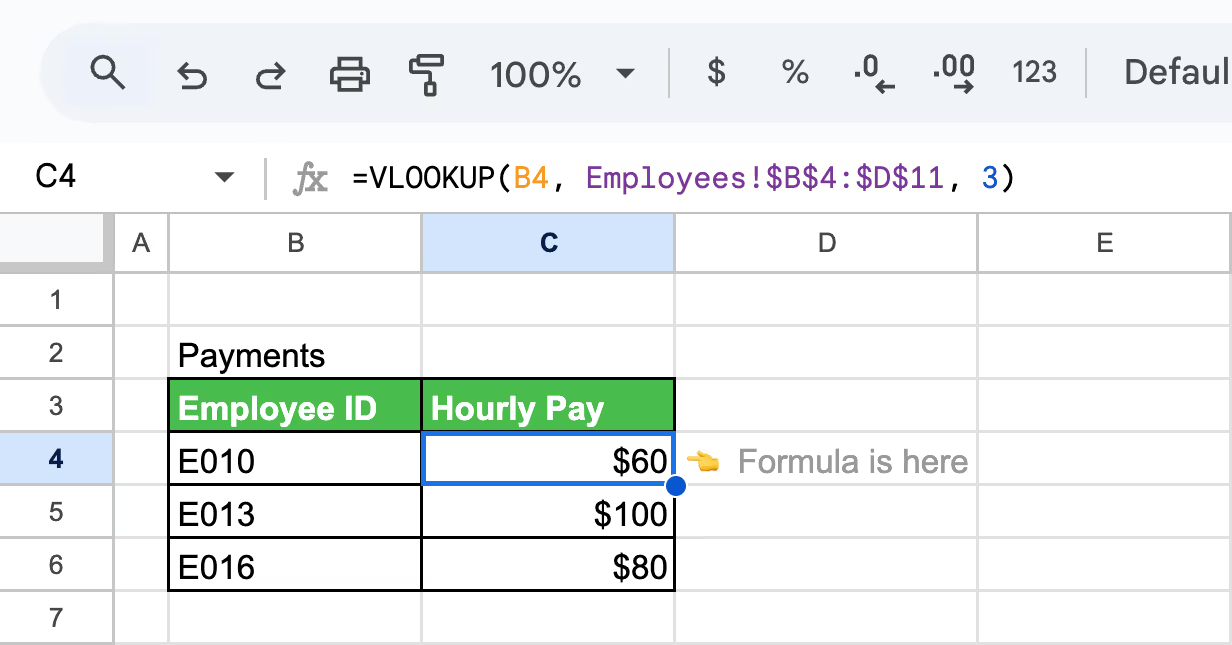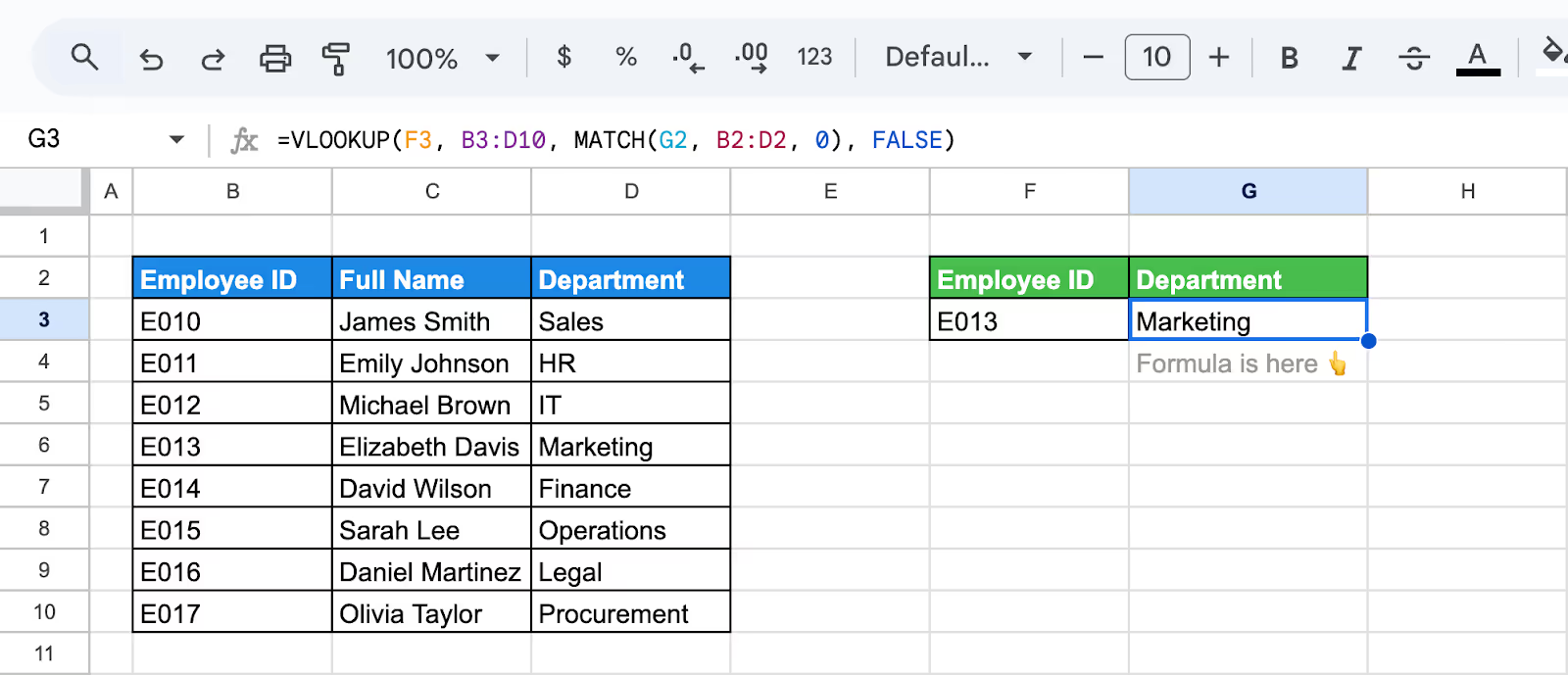If you work with a large dataset in Google Sheets and need to find and bring together specific information quickly, the Google Sheets VLOOKUP function is the number one solution.
Let’s say you have a list of products and their prices in one table and a separate table with customer orders. You can also use VLOOKUP to match these tables, save time manually cross-referencing, and ensure accurate pricing in your records.

With a few tricks, you will confidently handle data and won’t make mistakes in your formulas. In this article, we’ll walk you through these tips and tricks so that you can start using this function without any challenges.

VLOOKUP in Google Sheets is a function that helps you find and retrieve information from a table. It's similar to a search function for your spreadsheet. You give it a value to look for, tell it where to search, and then it retrieves the corresponding data. It's convenient if you need to quickly get specific data without manually scanning through a large dataset.
🎥 Looking for a more visual explanation? Watch our detailed video on using VLOOKUP in Google Sheets. This video complements the article and provides step-by-step guidance to enhance your understanding.
This is the standard VLOOKUP formula:
=VLOOKUP(search_key, range, index, [is_sorted])
We will be using an employee dataset to demonstrate the VLOOKUP formula in Google Sheets.
Suppose you have a “Full Name”, “Department” and “Salary” dataset, and you want to fetch the salary of an employee by their name in a separate table.
You can use the following formula:
=VLOOKUP(B3, B:C, 2, FALSE)

Here:
This formula retrieves the salary of the employee listed in C2 and displays it in the corresponding cell in the “Salary” column of the new table.
Using the VLOOKUP function in Google Sheets has several advantages that help handle data. Let's look at 5 of them:
Now that you have a better grasp of the function, let's see some common examples of using VLOOKUP. Here are various ways you can apply VLOOKUP formulas in Google Sheets.
VLOOKUP can be used to find values based on partial matches, making it a powerful tool for scenarios where you don’t have the complete search key. By combining the lookup value with a wildcard (*), you can locate entries that start with specific characters or contain a particular string.
This flexibility is ideal for dynamic lookups. However, VLOOKUP only returns the first matching result by default. When there are multiple matched search keys, ensure these keys are assigned unique values to facilitate proper searching and avoid unexpected behaviors.
Suppose you have a list of full names and email addresses in a dataset, and you want to find an email address based on the first few characters of a name.
You can use this formula:
=VLOOKUP(F2&"*", B3:C10, 2, FALSE)

Here:
If F3 contains “eli”, the formula will return: elizabeth.davis@example.com
Using this method, you can dynamically search for email addresses without knowing the full name. It’s handy for large datasets where only partial information is available.
VLOOKUP with an exact match searches for a specified value in the first column of a range and returns a corresponding value from another column. Using the exact match ensures that only precise matches are retrieved, making it ideal for accurate data lookups.
Suppose you have a dataset with employee names, emails, and their respective departments. You want to find an employee's department based on their email address. Here’s how to do it using VLOOKUP with an exact match.
You can use this formula:
=VLOOKUP(G2, B3:D10, 3, FALSE)

Here:
Using VLOOKUP with the full range and the correct column index ensures accurate retrieval of data, like the department based on an email address.
VLOOKUP can go beyond basic lookups to handle more complex tasks. These advanced applications enable more dynamic and flexible data management for robust spreadsheet solutions.
VLOOKUP can be used to compare two columns and identify common or missing values, making it a valuable tool for data analysis. By using one column as the search key and another as the lookup range, you can easily determine matches or discrepancies between datasets, streamlining comparisons for large datasets.
Suppose you have two columns of email addresses, and you want to find emails in the Left List that also appear in the Right List. Using the VLOOKUP formula, you can compare the two columns and identify matching values.
You can use this formula:
=VLOOKUP(C3,D$3:D$10,1,FALSE)

Here:
This formula effectively identifies matching emails between the two lists. Matching emails are displayed, while non-matches are shown as #N/A. Use this approach for quick comparisons in Google Sheets.
The VLOOKUP function doesn’t natively support multiple criteria, but you can work around this limitation by creating a helper column that combines the criteria into a single value. This approach acts as a conditional VLOOKUP that allows you to search for matches based on multiple fields, such as first name and last name, for more precise lookups.
Let’s use the dataset where First Name and Last Name are split into two columns, and we create a helper column to join them for finding the department of "James Smith."
Let's first create a helper column for combining the names:
=C3&D3

In this scenario, we have added First Name in cell H2 and Last Name in cell H3. Now, to find the department for "James Smith" by combining the first and last names directly in the formula.
Use the following formula in H4:
=VLOOKUP(H2&H3,B3:E10, 4, FALSE)

Here:
💡Learn how to handle complex data lookups using multiple criteria with this comprehensive guide. Simplify your tasks and unlock advanced functionality in Google Sheets. Read more here: VLOOKUP with Multiple Criteria in Google Sheets.
VLOOKUP can be used to retrieve data from a different sheet within the same spreadsheet file. By referencing the sheet name and the range, you can seamlessly perform a VLOOKUP from another sheet for better data organization and analysis.
In this scenario, we have two sheets: Employees and Payments. The goal is to retrieve the Hourly Pay for specific Employee IDs from the Employees tab sheet and display it in the sheet named – VLOOKUP on Another Sheet within the Same File sheet.

Here’s how to fetch the Hourly Rates for Employee IDs E010, E013, and E16 from the “Employees” sheet and display them in cells C4, C5, and C6 on the other sheet.
Use the following formula in C4:
=VLOOKUP(B4, Employees!$B$4:$D$11,3)

Here:
By using the VLOOKUP function with a reference to another sheet, you can efficiently fetch and display relevant data like hourly pay for employees.
VLOOKUP becomes even more powerful when combined with other functions. These combinations allow you to handle complex scenarios, automate data processing, and create dynamic, flexible formulas for advanced data analysis and management.
VLOOKUP can retrieve data from a different spreadsheet file by combining it with the IMPORTRANGE function. This allows you to access and search for values across files, making it ideal for managing and analyzing data stored in multiple spreadsheets.
Suppose you want to retrieve the Hourly Pay for a specific Employee ID (E010) from an external spreadsheet file containing the "Employees" data, and display it in the current sheet tab named – VLOOKUP Using IMPORTRANGE.
So, the employee dataset is in another spreadsheet, which is the source spreadsheet:
The URL is: https://docs.google.com/spreadsheets/d/1vTAjL1QL_LwB03N6w51ZVOsjoepHFLdTpKDEB9LXPA4/edit?gid=0#gid=0

Use the following formula in a current spreadsheet in cell C3:
=VLOOKUP(B2,IMPORTRANGE("https://docs.google.com/spreadsheets/d/1vTAjL1QL_LwB03N6w51ZVOsjoepHFLdTpKDEB9LXPA4/edit?gid=0#gid=0","Employees!$B$4:$D$11"),3)

Formula explanation:
Using VLOOKUP with IMPORTRANGE allows you to retrieve data from another workbook file seamlessly. Ensure proper access permissions are granted, and always lock your ranges to maintain accuracy when dragging formulas.
💡 Essential for bringing in data from multiple external sources, the IMPORTRANGE function significantly improves the capabilities of data analysis. Check out our complete guide on using IMPORTRANGE, and get a free template to make the most of this powerful tool.
VLOOKUP combined with ARRAYFORMULA allows you to retrieve data for multiple rows and columns simultaneously, saving time and effort. Instead of applying the VLOOKUP formula row by row, this method dynamically processes entire ranges, making it an efficient solution for large datasets or complex lookups.
In this example, we’ll use VLOOKUP with ARRAYFORMULA to dynamically retrieve multiple columns of information (Full Name, Email, and Department) based on Employee IDs.
Use the following formula:
=ARRAYFORMULA(VLOOKUP(G4:G6, B3:E10,{2,3,4}, FALSE))

Here:
Using ARRAYFORMULA with VLOOKUP, you can retrieve multiple columns of data dynamically for several rows at once.
Using VLOOKUP with MATCH lets you dynamically retrieve data from a specified column by referencing its header. This eliminates the need to hard-code column indices, making your formulas more adaptable to changes in data structure or column order.
In this example, we use VLOOKUP with MATCH to dynamically select the column to retrieve data based on a header value. We will extract the department of an employee, using their Employee ID as a search key.
Use the following formula:
=VLOOKUP(F3, B3:D10, MATCH(G2, B2:D2, 0), FALSE)

Here:
By combining VLOOKUP with MATCH, you can dynamically retrieve data based on column headers, such as the department of an employee using their ID.
Combining VLOOKUP with IF and ISNA allows you to perform lookups while managing missing or invalid data. If the lookup value isn’t found, ISNA detects the error, and IF provides a custom output, like a message or default value, instead of showing an error.
Suppose you want to retrieve the salary of an employee based on their Employee ID. If the Employee ID is not found in the dataset, you want to display a custom message like "Employee Not Found" instead of an error.
Use the following formula for the selected employee ID:
=IF(ISNA(VLOOKUP(F3, B3:D10, 3, FALSE)), "Employee Not Found", VLOOKUP(F3, B3:D10, 3, FALSE))

Here:
This formula efficiently combines VLOOKUP, IF, and ISNA to handle missing values and provide meaningful outputs, ensuring smooth and error-free data lookups.
💡 Learn how to combine VLOOKUP with IF statements in Google Sheets to handle missing data and create dynamic, error-free lookups. Explore the full guide here: How to Use VLOOKUP with IF Statement in Google Sheets.
VLOOKUP is a powerful tool, but errors can arise if the function is not set up correctly. Understanding the most common issues and their solutions ensures accurate and efficient lookups. Let’s explore the typical errors encountered with VLOOKUP and how to resolve them step by step.
⚠️ Cause: The #N/A error occurs when the lookup value is not found in the first column of the table array, which is required because Google Sheets VLOOKUP can’t look to the left. This error can also occur due to data type mismatches, such as numbers stored as text or vice versa.
✅ Solution: Ensure the lookup value exists in the first column of the table array. Use the more flexible INDEX MATCH combination, which lets you return values from any direction, left or right, by referencing ranges directly. Verify there are no data type mismatches, such as numbers stored as text or vice versa.
⚠️ Cause: The #REF! error typically arises when the column index number (col_index_num) in the VLOOKUP function is invalid. This happens if it’s less than 1 or exceeds the number of columns in the table array.
✅ Solution: Verify the col_index_num argument. Ensure it falls within the range of columns in the table array and accurately references the column you want to retrieve data from.
⚠️ Cause: The #NAME? error signifies that Google Sheets doesn’t recognize part of the formula. This could result from misspelling the function, an undefined named range, or an incorrectly spelled named range.
✅ Solution: Double-check the spelling of the VLOOKUP function and any named ranges. Ensure the named range exists and is properly defined in your spreadsheet.
⚠️ Cause: The #VALUE! error occurs when the range argument in the VLOOKUP function is invalid. This might happen if the range includes non-numeric characters or if the range isn’t properly defined.
✅ Solution: Review the range argument to confirm it’s a valid reference and doesn’t include non-numeric characters. Check the accuracy of cell references if the range is manually defined.
VLOOKUP is a powerful tool for data lookup and organization, but using it effectively requires careful attention to its rules and limitations. Following best practices ensures your formulas are accurate, efficient, and error-free.
VLOOKUP requires the search key to be in the first column of the specified range. If it isn’t, you’ll need to rearrange your data or modify the range. This is a key limitation of VLOOKUP, as it cannot look to the left of the search key for matching values. Plan your data layout accordingly.
VLOOKUP always returns the first instance of a matching search key. If there are duplicates, it won’t retrieve values for subsequent matches. Consider using alternative functions like FILTER or QUERY to handle duplicate values, which provide more advanced options for working with multiple results. This ensures a more comprehensive analysis.
To copy the VLOOKUP formula across cells, use absolute references (e.g., $A$1:$B$10) for your range. This helps lock the VLOOKUP formula and ensures the range remains fixed when you drag the formula to other rows or columns, preventing errors caused by shifting references. Consistent referencing makes your formulas more reliable and easier to manage.
Errors often occur due to incorrect ranges or column index numbers. Ensure your range includes the search key column and the desired return column. Verify the column index corresponds to the position of the return column within the range for accurate results. Cross-checking these details saves time in debugging.
Practicing VLOOKUP with various datasets is essential to mastering it. Experiment with exact matches, partial matches, and data spread across sheets. The more you practice, the better you’ll understand its functionality and how to troubleshoot common issues effectively. Familiarity with varied scenarios builds confidence.
Google Sheets is equipped with a variety of powerful formulas that streamline your data analysis efforts-
Simplify your data analysis in Google Sheets with the OWOX: Reports, Charts & Pivots Extension. Effortlessly create detailed reports, dynamic charts, and comprehensive pivot tables to manage large datasets and achieve precise visualizations. OWOX streamlines your analytics, making complex tasks simple and efficient.
Designed for advanced data analysis, this tool empowers you to interpret and utilize your data effectively. Gain clear insights and make informed decisions with features tailored to provide clarity and actionable results.

Yes, VLOOKUP can search for values both vertically and horizontally in Google Sheets. The orientation depends on how the data is arranged in the specified range.

You set the range for a VLOOKUP search by indicating the sheet name, if applicable, followed by an exclamation mark (!), and then providing the cell range within which you want to search.

VLOOKUP in Google Sheets is not case-sensitive. To perform a case-sensitive lookup, you can use a combination of functions like EXACT or helper columns to convert text to a consistent case.

To reference data from another tab using VLOOKUP, include the sheet name followed by an exclamation mark (!) before setting the cell range in the formula.

VLOOKUP in Google Sheets searches from left to right. If you need to search from right to left, you can use the INDEX and MATCH functions combined.

Yes, VLOOKUP can search data from another sheet in Google Sheets. You need to select the range using the sheet name, followed by an exclamation mark (!), and then the cell range.

The "column index number" in a VLOOKUP formula refers to the column from which you want to retrieve data. It shows the relative position of the column within the specified range.

VLOOKUP in Google Sheets is used to search for a specified value in a column, and when found, retrieve information from the same row in a different column. It's commonly used for data analysis, lookup operations, and organizing information.

Use VLOOKUP to compare two lists by checking if each item in one list appears in the other. Return matched values or errors to quickly spot duplicates or missing entries.